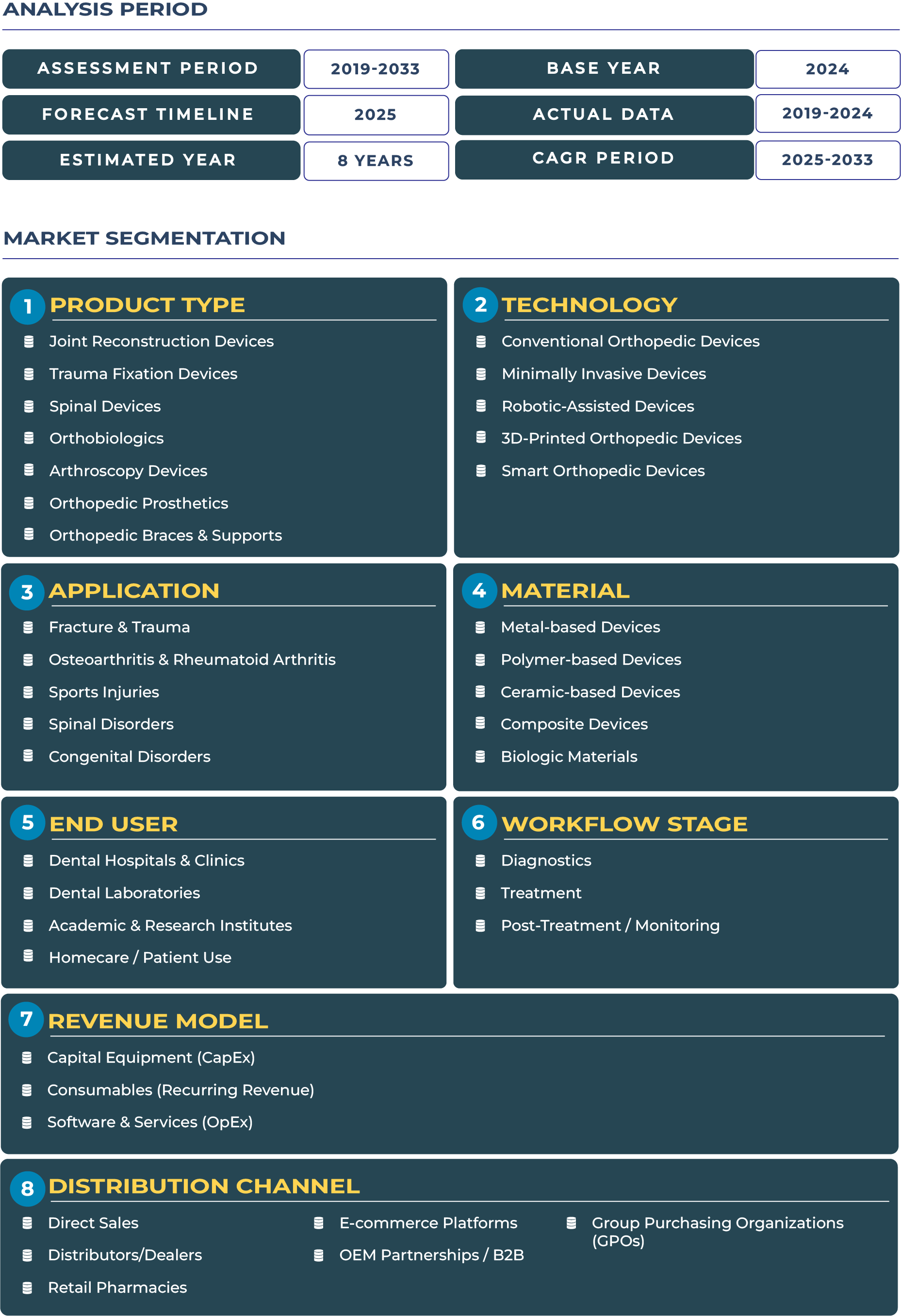Singapore Orthopedic Devices Market Outlook: Singapore’s Emergence as a Premium Medtech and Orthopedic Innovation Hub
Singapore has positioned itself as a premium healthcare hub in Asia, where medical innovation and patient-centric outcomes drive adoption across specialized sectors such as the orthopedic devices industry. With its globally recognized regulatory clarity, strong government backing, and thriving medical tourism ecosystem, Singapore has become a gateway for advanced implant trials, premium surgical techniques, and next-generation orthopedic technologies. In 2025, the Singapore orthopedic devices market is estimated to reach USD 479.8 million and is forecasted to expand to USD 902.6 million by 2033, reflecting a CAGR of 8.2% between 2025 and 2033. This growth trajectory is anchored by increasing demand for complex procedures such as joint reconstruction, spinal interventions, and arthroscopy, all driven by aging demographics, high prevalence of musculoskeletal disorders, and affluent patient groups willing to invest in advanced orthopedic solutions. As a nation branding itself as a premium medical destination, Singapore Orthopedic Devices sector is set to maintain its position as one of Asia’s most innovative healthcare markets.
Singapore’s Healthcare Leadership Strengthening orthopedic devices market Growth
Singapore Orthopedic Devices ecosystem benefits significantly from the country’s reputation as a global healthcare leader. The premium nature of its healthcare system, underpinned by institutions such as the Ministry of Health Singapore, creates strong demand for high-value implants and precision orthopedic solutions. The combination of world-class hospitals, including internationally accredited private institutions, with an ecosystem designed for medical tourism has made Singapore a preferred destination for patients across Southeast Asia seeking advanced orthopedic surgeries. The orthopedic devices landscape is also being shaped by significant R&D initiatives, particularly in biologics and minimally invasive arthroscopy techniques, which align with Singapore’s innovation-driven healthcare policy framework. The orthopedic devices market outlook indicates a steady balance between imported premium implants and locally developed solutions, fostering sustainable long-term growth. In the face of global uncertainties such as geopolitical tensions and supply chain realignments, Singapore’s stable economic and political environment ensures resilience in the orthopedic devices sector while providing a platform for regional orthopedic device exports.
Drivers & Restraints: Key Factors Shaping Singapore Orthopedic Devices Industry
Drivers: Singapore’s Role as a Regional Medtech Powerhouse
Singapore Orthopedic Devices industry is propelled by its role as a hub for high-value medical technology. The city-state is home to a concentration of multinational headquarters and R&D facilities that conduct cutting-edge orthopedic research. Regulatory clarity from agencies such as the Health Sciences Authority enables faster time-to-market for implants and devices, while Singapore’s aging population creates a sustained pipeline of demand for joint replacement, spinal correction, and trauma fixation procedures. The growing role of private hospital chains in offering specialized orthopedic care enhances demand for trauma fixation devices and premium prosthetics. Furthermore, Singapore’s role as a hub for clinical trials allows medical device companies to launch orthopedic innovations first in Singapore before scaling across ASEAN.
Restraints: Challenges of Market Scale and Competitive Dynamics
Despite its innovation-led growth, Singapore Orthopedic Devices market faces limitations due to its relatively small domestic population, which restricts the volume of procedures compared to regional giants. High entry costs for manufacturers, including regulatory compliance and distribution networks, add to market barriers. Competition from neighboring markets such as Malaysia and Thailand, which offer lower-cost orthopedic surgeries, puts pricing pressure on Singapore’s ecosystem. While Singapore dominates in advanced implants and high-value procedures, the orthopedic devices sector must continue differentiating through innovation and specialized services rather than competing solely on volume. The fragmented nature of regional orthopedic device adoption also requires Singapore-based players to rely on export-driven growth strategies.
Trends & Opportunities: Shaping the Future of Singapore Orthopedic Devices Landscape
Trends: Innovation and Premium Implant Uptake
Singapore is witnessing a strong trend toward the adoption of premium implants, including advanced knee and hip replacements designed for minimally invasive procedures. Orthobiologics and stem-cell-based interventions are gaining traction within leading hospitals, positioning Singapore at the forefront of biologically enhanced orthopedic treatments. The presence of clinical research centers has enabled Singapore to attract trials for advanced spinal devices and arthroscopic innovations, reinforcing its status as a testing ground for global orthopedic manufacturers.
Opportunities: Leveraging Clinical Excellence for Regional Growth
The Singapore orthopedic devices market is ripe with opportunities in areas such as clinical trial partnerships, training symposia for regional surgeons, and export of clinical expertise to ASEAN markets. Establishing Singapore as a premium orthopedic showcase center provides global manufacturers with a platform to demonstrate next-generation prosthetics, fixation systems, and biologics to investors and hospitals across Asia-Pacific. The development of localized implant solutions tailored for Asian anatomy further strengthens opportunities, especially as Singapore increases collaboration with universities and specialized medical innovation hubs to commercialize orthopedic devices. This combination of innovation, regional outreach, and clinical excellence presents a pathway for Singapore to reinforce its leadership within the orthopedic devices ecosystem.
Competitive Landscape: Singapore as a Launchpad for Orthopedic Multinationals and Local Innovators
The orthopedic devices industry in Singapore is shaped by the presence of international leaders such as Smith & Nephew, Stryker, and Zimmer Biomet, alongside local innovators leveraging the country’s medtech-friendly ecosystem. Multinationals use Singapore as a regional HQ and R&D hub to run pan-ASEAN pilot trials, highlighting the country’s advanced clinical infrastructure. Local players, meanwhile, are investing in developing cost-effective prosthetics and arthroscopy tools that can cater to regional markets. For example, orthopedic companies are increasingly hosting training symposiums in Singapore to strengthen surgeon education, which enhances the adoption of advanced implants across the region. The convergence of government initiatives, private hospital expansion, and multinational investments ensures that Singapore Orthopedic Devices market remains competitive and innovation-driven, setting benchmarks for quality and patient outcomes across Southeast Asia.







